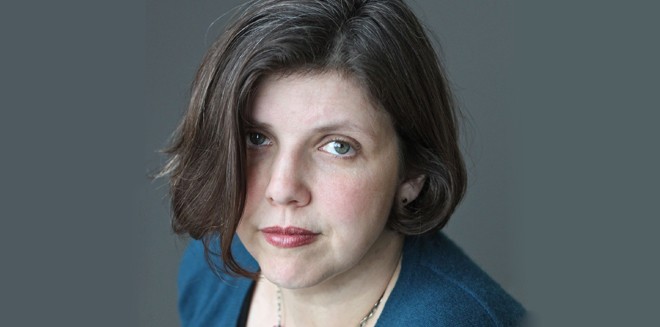

The story is about a marriage: a cheating husband and an academic wife and their quirky daughter. But the book never becomes chick lit or Oprahfied. The narration is peppered with seemingly unrelated bits of information which add an extra layer of lucidity to the voice of the narrator, the wife.
For example: the first two sentences of the novel are "Antelopes have 10× vision, you said. It was the beginning or close to it. That means that on a clear night they can see the rings of Saturn."
These opening sentences introduce the protagonist and her interlocutor but the bit of information they are discussing appears irrelevant to the story. Even Peter Høeg does not manage this intensity and lucidity when his famous protagonist Smilla Qaaviqaaq Jaspersen in Miss Smilla’s Feeling for Snow is sprinkling her narrative with bits of scientific and lucid information.
Though there is a considerable similarity in the narrative technique -- interspersing the story with bits of unrelated information, Høeg is more politically aware with the selection of information because he is pitting Innuit culture against European culture through his female protagonist, a rebel and an outsider. He is aware of the fact that the Innuit people do not measure distance in units of kilometres but rather in "sleeps" -- the number of nights required to cover a distance.
Jenny Offill, on the other hand, employs the technique to convey an emotional landscape which does not question the institution of monogamous marriage as a guarantor of private property, entitlement, inheritance and, as a consequence, of almost all prevalent social hierarchies and the state. Her narrator just wants to experience fidelity, the emotional equivalent of treating another human being as a property. When her desire to treat her partner and be treated by him as a fully owned human being is thwarted, her emotions set the narrative form on fire. The narration itself becomes illustrative of the dictum: property is war.
Instead of questioning the politics of her desire for an absolute ownership of a living creature through the institution of marriage, the narrator starts looking at herself as an object. The shift is from the first person to the third person objectification of herself. Now the "I" of the story is "the wife" going through the turmoil of having to deal with infidelity.
To complicate the ideas of justice and equality and redemption, she also tries to meet her own former lovers but the meetings do not help control the emotional demolition she is experiencing.
If the reader can ignore the political platitude at the heart of the narrative, the stereotypical cheating husband and the distraught wife trying to break free or get even, the craft of the novel is innovative and the execution of narrative techniques is flawless.
This book also hammers home another point that is often mentioned in books on the craft of writing, such as No Plot, No Problem by Christ Baty -- if you have a unique voice, you don’t need a very clever plot or a plot at all. The voice of the narrator is enough to carry the narrative to its conclusion.
And Jenny Offill proves this point with an amazing dexterity. From the outset, after the conflict has been introduced, there are only two outcomes -- either the marriage will survive or it will be dissolved.
Both the outcomes do not appear very thrilling for the contemporary reader who is familiar with Bret Easton Ellis, Douglas Coupland, Christos Tsiolkas, Andrew McGahan and Reinaldo Arenas.
But it is the voice of the narrator and the exquisite sampling of objective knowledge used for a very emotive purpose that saves the story from becoming a platitude or a cliché. The writer has honoured the intensity of the narrator’s desire to remain within the structures of institutionalised love.
There is another risk associated with a narrative that has only two main characters and they are estranged -- the narrator can become a cardboard character because there are not human interactions to show the depth of the character.
Jenny Offill has solved this problem by employing two techniques -- the first is supplying deeply personal information through answers to self-interviews and the second is the profession of the narrator. She is a teacher and her students help her reveal her own personality to the reader through their interactions with her. Here is an example of the self-interview technique:
"Personality Questionnaire
1. I enjoy the sensation of speeding in a car.
2. Others know me by the long hours I keep.
3. I am drawn to games of chance.
4. Parties make me nervous.
5. I eat more quickly than other people.
6. Friends have called me thin-skinned.
7. I prefer indoor activities.
8. Often, I fear I am not up to life’s challenges.
9. I would like to learn to fly an airplane.
10. Sometimes I am restless for no apparent reason."
And this technique comes quite handy throughout the novel. Then at the height of the narrator’s emotional distress, a student is hospitalised after an attempted suicide. The suicidal student suffers from insomnia just like the narrator and it helps the reader gauge the extent of the narrator’s distress -- "Sleep is the thing Lia won’t do. She never sleeps unless they drug her. But she never rings the call button in the middle of the night either. ‘I just wait for first light,’ she says. ‘I watch the window.’ This is how the wife gets through the nights too, but she doesn’t tell her this."
There is this type of emotional lucidity packed with some of the most cutting-edge literary devices that make this novel a mandatory reading for any creative writing course and the connoisseurs of contemporary literary fiction who like to empathise with a very cerebral protagonist.